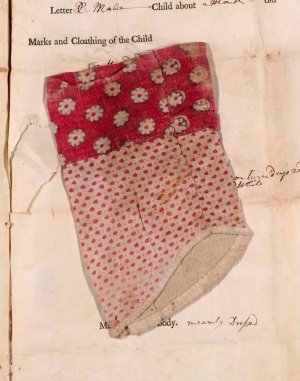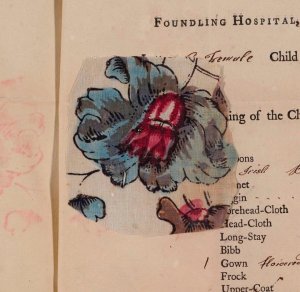The Fabric of Their Lives
I’m delighted to welcome Courtney Barnes of Style Court as a guest contributor to Enfilade. With a B.A. in art history and an M.A. in education, Courtney has worked as a docent at the High Museum of Art in Atlanta and has contributed to Southern Accents, among other publications. Established in 2006, Style Court has won praise from Time, Elle Decor, Domino, Atlanta Homes & Lifestyles, 1stdibs, Country Living, and Apartment Therapy L.A. Courtney’s site does a particularly good job of bringing together a wide variety of people interested in design and the arts. While Enfilade has previously included postings that were sparked by coverage at Style Court, it’s a treat to hear from Courtney directly – and on textiles, a topic that’s of special interest to her. As a HECAA member, Courtney (I hope) will have more postings to share from time to time in the future. -CH
◊ ◊ ◊ ◊ ◊
Threads of Feeling
The Foundling Museum, London, 14 October 2010 — 6 March 2011
B y C O U R T N E Y B A R N E S
In 2003 I ventured down into the densely packed textile and costume archives of the Atlanta History Center to meet with curator Susan Neill. At the time, she was preparing for the opening of Gone With the Girdle: Freedom, Restraint and Power in Women’s Dress, an exhibition that used the familiarity and allure of fashion to engage a general audience in the social, economic, and political history of women living in the southeastern United States from the nineteenth century up to the present.
In addition to the always crowd-pleasing couture, Neill brought into the galleries more common garments including a restrictive maternity corset, a domestic worker’s evening uniform, the first pantsuit designed for Delta Airlines flight attendants, a mini skirt half slip, and jeans — all to tell a story of radical change. Not surprisingly, such everyday articles of clothing worn on the job by waitresses and domestic workers were harder for Neill to obtain since they were typically discarded due to wear and tear or lack of interest. And examples of clothing worn by slaves during the antebellum era eluded Neill completely.

"Sleeves red and white speckl’d linen turn’d up red spotted with white." A baby’s sleeve made from linen © Coram
This simple but profoundly ironic rule of material culture — that the most common and mundane traces of the past, especially when associated with the working classes and the poor — are the least likely to survive makes an upcoming exhibition at The Foundling Museum in London all the more remarkable. Threads of Feeling showcases women’s and children’s textile tokens from the middle of the eighteenth century. The exhibition curator, John Styles, a specialist in the material culture of eighteenth-century Britain, has assembled a selection of fabric tokens that have survived some 250 years in the archives of The Foundling Hospital. Beginning in the 1740s, the institution served as a last resort for many of London’s impoverished, unmarried women who found themselves unable to care for their infants. A single identifying record, usually a clipping of fabric, was typically left at the
Foundling when the child was accepted.

"A bunch of 4 ribbons narrow – Yellow, Blue, Green, & Pink." Silk ribbons tied in a bunch with a knot © Coram
As noted at the Museum’s website:
In the cases of more than 4,000 babies left between 1741 and 1760, a small object or token, usually a piece of fabric, was kept as an identifying record. The fabric was either provided by the mother or cut from the child’s clothing by the hospital’s nurses. Attached to registration forms and bound up into ledgers, these pieces of fabric form the largest collection of everyday textiles surviving in Britain from the 18th Century.
Because the babies were essentially adopted by an institution (rather than a particular family) and were rarely reclaimed, Threads of Feeling provides both a material and emotional window into the past. Styles comments on his own website:

"Flowered lawn." Lawn printed with flowers © Coram
The textiles are tangible evidence of babies abandoned, many destined to die within a few days or weeks. To see them is a poignant, emotional experience. But the textiles are also beautiful objects in their own right. Most are colourful, patterned fabrics that served as tokens precisely because they were visually arresting. At the same time, they witness a rich social history. They show how ordinary people conducted their romances, clothed their babies, and engaged with fashion, providing a market for the cotton fabrics that were fundamental to the Industrial Revolution of the later 18th century.
For anyone who would like to learn more about the antique textile tokens, the September-October 2010 issue of the British-based textile magazine, Selvedge, features a terrific, in-depth cover story on the exhibition written by Shelly
Goldsmith. Selvedge is available at select bookshops in the
U.S. and by subscription, in digital or traditional paper formats.




























I appreciate the warm introduction and the opportunity to contribute. Many thanks. The exhibition of textile tokens is certainly thought provoking. I’m anxious to learn how museum visitors respond.
This is a beautifully written piece. And what an extraordinary exhibition! It is interesting how textiles hold such meaning as keepsakes. I am thinking of 19th-century Valentines, often made from bits of dress and upholstry fabrics belonging to loved ones.
A fascinating article and a very touching subject for an exhibit. There are few things more intimate than a cloth once worn attesting to life.
An incredible exhibit. I sent for the catalogue and love it. Heather (hezah)